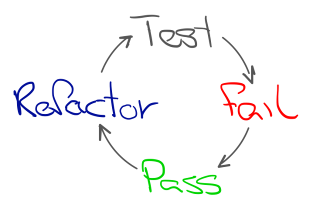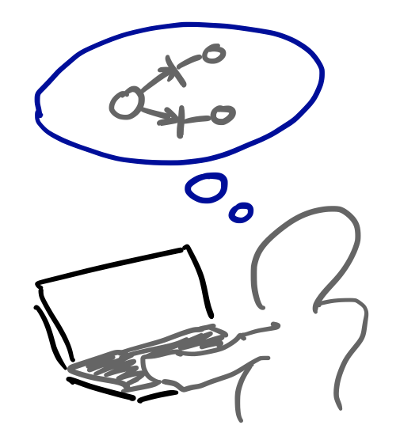When writing a test, we don’t just think about how to formulate the test. We think about design - the design of the code-under-test and the context in which it fits. Writing a test is an act of design.
Where is design in Test Driven Development?
Looking at the TDD cycle, we can ask ourselves: where is the design step?

Spoiler: Design is in all the steps.
A test is an example of how the code-under-test will be used. Writing a test before the production code means you’re specifying the API of the code-under-test and making this concrete in code. The test expresses an example of both the syntax - method names, parameters - and semantics - what is the behaviour, what do the methods do.
This is a post in our series on Test Driven Development.
Example
Let’s look at an example from one of our course exercises. In this exercise, we are test-driving the design and implementation of a drinks vending machine model. One of the tests that have to do with paying for drinks is:
1
2
3
4
5
6
7
8
9
10
11
12
13
14
15
# Using Python & pytest
class VendingMachine:
def configure(self, choice, can, price):
...
def insert(self, amount):
...
def deliver(self, choice):
...
def test_delivers_when_paid_enough():
machine = VendingMachine() # 1
machine.configure(Choice.Cola, Can.Coke, 2) # 2
machine.insert(2) # 3
result = machine.deliver(Choice.Cola) # 4
assert_that(result, equal_to(Can.Coke))
We create a VendingMachine object (1). We configure its choices (buttons) through a configure function, and we decided to pass the price as a third parameter here (2). We also decided to represent the price by integers, something we will probably get to regret sooner rather than later. It is unclear whether it represents cents, euros, dollars, tokens…
Aside: we rarely see course participants introduce a Money concept at this point, or at all. Many of us remain blissfully unaware of how complicated Money can be to represent properly. Quite often we even see floating point numbers used to represent money. Ignorance is bliss. Until it bites you.
We decided that to get a priced drink, we first need to insert money (3) and then choose a drink (4).
Code is unambiguous, we need to be precise in how the code-under-test is going to work. Like in this small example, we are making (micro) design decisions all along the way.

Writing a test is an act of design
Early, fast feedback
By expressing your design decisions precisely in code, your test will already provide feedback about these decisions: e.g. names, parameters, results, errors, call semantics, data structure, interfaces and composition - how the parts fit together.
So take your time to think your test through. Then observe the test code once written. If you don’t like what you see, change is still cheap: revisit your decisions, rewrite the test.
The Test step of the TDD cycle is a step to think about design. This cuts both ways: it benefits both the design of the production code and the readability of the test.
The Refactor step is also a great place to think about design. Once the rush to produce shiny new code and the anxiety of “will this work” have waned, we can now calmly consider if this code is any good, and how well it resolves the forces for our design. We might delve into this later.
Conclusion
A design is a side-effect of working test-first. Working mechanically, by just following the steps is not enough. A good design requires thinking all the time - before, during and after writing a test.
We are capable of getting a complicated design under test. We prefer not to. If we can get an understandable, maintainable design with understandable, effective tests, we are happy. We won’t settle for anything less.
Reading
That is why test-driven development is a big win. Writing tests first forces you to focus on thinking about the interface before you design and code it. Making those tests work becomes a relentless way of getting observable behaviour to work rather than letting crufty untested code pile up.
– Little things add up, Rebecca Wirfs-Brock
- Kent Beck, Test Driven Development, By Example (2002)
- Steve Freeman and Nat Pryce, Growing Object Oriented Software, Guided by Tests (2008)
“Think about design in test” is a heuristic, not a hard rule. We haven’t defined heuristics yet. Oops. In the meantime, have a read through Growing Your Personal Design Heuristics Toolkit by Rebecca Wirfs-Brock if you’d like to get a grasp on what a heuristic is, and what heuristics could do for you (especially your own).
